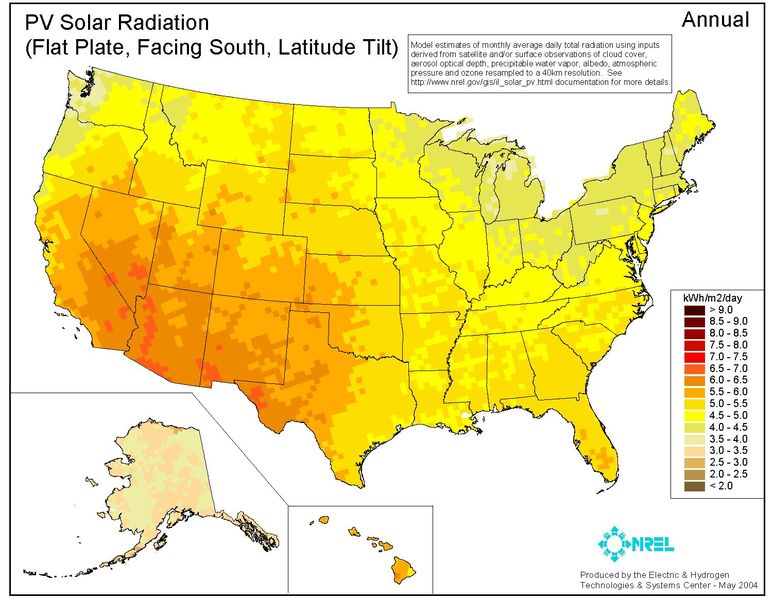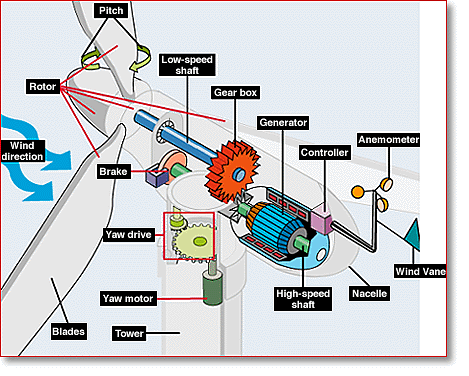Archive for October, 2006
$10.5B quarterly profit
Exxon reported $10.5B in profit for their most recent quarter of activity. Another quarterly report, another $10B profit, it’s good to be Exxon. That’s what they call in the business, real money…$1350 profit per second.
If just this quarter of Exxon’s profit was invested in renewable electricity generation using wind, it could fund approximately 10 GW of production leading to around 26 terawatt hours (TWh) (or 26,280,000,000,000 watt hours) of power and that could displace about 26 million kilotons of pollutants annually. This would require the investment of just ONE quarter’s profit.
The economic payback? About 13 years at current electric power prices ($30/MWh net of expenses.)
The lifetime profit? ~$11B.
The public relations and image value? Priceless.
Technorati Tags: Energy | Exxon | Profit
OPEC, cartel extraordinaire
If it wasn’t so sad, it would be funny that many countries with interests counter to the US are profiting immensely from our energy demands. Let’s face it, our appetite for energy in the US is insatiable. As a result, we can as a country be held hostage by those who have the resources necessary to supply our habit and those same people may engage in outright hostile activities toward the US with very little worry of reprisal (with the present situation in Iraq.)
What is the Organization of the Petroleum Exporting Countries (OPEC) anyway? According to the OPEC website it is:
OPEC is a permanent, intergovernmental organization consisting of 11 developing nations, whose economies rely on oil export revenues. One of OPEC’s primary missions is to achieve stable oil prices, which are fair and reasonable to consumers and producers.
If we view the dictionary.com definition of cartel, it states: an international syndicate, combine, or trust formed especially to regulate prices and output in some field of business. Let’s be plain about this, OPEC was founded to be a cartel, has the mission of a cartel, and is a cartel beholden to no one, but it’s 11 member states. Curiously, if the consumers of it’s product were smart enough and had sufficient will to respond to the cartel in an organized and consistent way, they could bring it down. (Other than demanding that the cartel produce more and not charge too much for that right…..which is what these consumers do now.) Why does this cartel have so much power? Because it controls 78% of the world’s proven petroleum reserves (897 billion barrels.)
Just who are the 11 OPEC member states?
- Algeria – Former French colony, now an unstable Arab state, 99% Sunni Muslim
- Indonesia – Former Dutch colony and Japanese possession, now a populous, predominantly Muslim (88%) state
- Iran – Formerly known as Persia, now a militant Islamic state suspected of supporting terrorism globally. Recently has asserted its right to join the nuclear nation club.
- Iraq – We’ve all heard enough about Iraq over the past 16 years.
- Kuwait – Former British colony, compartitively friendly post-liberation from Iraq, predominantly Muslim.
- Libya – Former Ottoman and Italian colony, recently reformed renouncing terrorism and weapons of mass destruction, predominantly Muslim.
- Nigeria – Former British colony, now an unstable African state, about 50% Muslim.
- Qatar – Former British protectorate, now a stable Arab state, predominantly Muslim.
- Saudi Arabia – A stable, Islamic monarchy. 100% Muslim.
- United Arab Emirates – Former British protectorate, progressive state by middle-eastern standards, predominantly Muslim.
- Venuzeula – Former Spanish colony and part of Gran Colombia, now stable socialist state, predominantly Catholic.
What do all these member states have in common? In general, they don’t care much for the US or our policies, but they’re happy to take our money to invest in our ultimate destruction. It’s rare to find such true irony.
By now you might be thinking “well this is depressing.” It is, but doesn’t have to be. With the technologies we have TODAY, we can make the decision to become independent of cartels simply by switching our focus and investment to renewable energy technology, both in electricity generation and in transportation. It can’t happen overnight, but it can happen within 20 years. BTW, what do you think you’ll be paying for a gallon of gasoline in 2026? I’ll bet you’re not saying $2.50…. A funny thing happens to unified producers when their largest, most dependent customer ceases to buy their product – they unravel from the inside out.
We have the ability to disentangle ourselves from this mess, shame on us if we don’t act upon it. The time to start is now.
Technorati Tags: Energy | Oil | OPEC
Community portable power bag (and lights)
If you’re into way off the grid living, this is an interesting way to get some light. The University of Michigan has done some prototyping on a “light bag” – effectively a solar textile that charges 6 individual lamps and/or a central battery.

Technorati Tags: Solar | Light | Energy
Let the sunshine in
You might recall “Aquarius/Let the Sunshine In” as a catchy little tune from the musical Hair, but that’s not what this entry is about…
It turns out that the energy in sunlight is measured at 250 watts/square meter on average across the US, or 3 KWh/square meter/day. See the NREL map below for details.

Now don’t go out and buy solar panels for your roof just yet, not all of that available energy can be directly translated into electricity, the best solar panels are about 15% efficient which means that one might harvest as much as 0.45 KWh/square meter/day into direct current, during day time. Obviously the amount of energy produced is related to location, hours of direct/indirect sunlight, and weather. So just what are these solar panels (photovoltaic cells) anyway?
Photovoltaic (PV) cells are a semi-conductor that absorbs sunlight (photons) into charge carriers (electrons) then directs them to a conductor. Typically, PV cells are grouped into arrays and placed on sheets or panels which in turn are arrayed to generate a desired amount of electricity. Solar panels have been in use for years in space applications, remote sensors, pocket calculators, and increasingly, for individual home power generation (or co-generation.)
There have been some efforts to get to utility scale with PV technology, but the cost remains prohibitive (~$0.20/KWh competing against $0.03-0.07/KWh for other technologies.) Japan and Germany have the most installed PV technology with the largest single installation rated at 12 MW peak production. To put this in perspective, the average fossil fuel plant in the US is rated at 219 MW peak production and the average nuclear plant in the US at 2,000 MW. As costs for PV continue to drop (as they have around 3% per year over the past few years) coupled with fossil fuel cost increases, the point at which PV becomes profitable at scale will likely happen in the next 15 years.
PV power generation does have some distinct advantages including $0 fuel costs, zero-emission power generation, long equipment lifespan, relatively low maintenance costs, and modular application scaling from micro-installations up to small utility size. The disadvantages to solar are in capacity factor, it’s only light so many hours per day and power demands are 24/7. Relatively speaking, it’s expensive to procure and install. And finally, the resulting power is direct current which further degrades efficiency as the power must be “inverted” to use on the grid or in typical AC household power systems. I’ve heard there may be some breakthrough research happening on the production of PV cells that radically change the costs of PV; if this happens, solar may become mainstream faster than any of us would expect.
Google is certainly making a go of it. Recently, the company announced a plan to install solar panels on its buildings (1.6 MW) and that the resulting power would satisfy up to 30% of the company’s energy requirement. Aside from being good for the planet, I presume someone ran the numbers to see this would at least be a slightly positive return on investment.
Technorati Tags: Energy | Solar | Photovoltaic
A mighty wind
And I’m not talking about the movie of the same title… Do you know how much a cubic meter of dry air weighs at sealevel?
About 1kg (1.0007 kg to be exact.) Air also has pressure, at sea level, about 10,194 kg/square meter (14.5 lbs/square inch.) Air also moves, you might have noticed this phenomena called wind. As the Sun heats the atmosphere air will naturally flow (convection) moving from high pressure areas to low pressure areas – it’s effectively a way for the atmosphere to move heat around.
So we’ve got mass and we’ve got movement which means that there must be a way to harness this excess energy flowing around the planet. For many thousands of years humans have used sails to capture the wind and for hundreds of years, sails anchored in place attached to a shaft converting wind energy to mechanical energy. This energy was used in the past to pump water, saw wood, grind things, etc. Today, high efficiency wind turbines are available and being installed for the purpose of converting wind energy into electricity.
Utility scale wind turbines

Each wind turbine has a shaft connected to a gearbox that drives an electrical generator. The turbines also have brakes, yaw and pitch controls, weather stations, and power transmission capability built into them (see diagram below.) Each turbine in a wind farm transmits its power to a shared substation where the electricity is stepped up to the right voltage to enter a supply line for the electricity grid.

The electric production capacity harvested from wind energy has grown from 2.8 gigawatt hours (GWh) in 1992 to 18.8 GWh in 2006 (trailing twelve month calculation.) Wind farms are now sprouting up in many different states across the US with Texas now leading wind production closely followed by California.
Major advantages to wind generated electricity start with fuel cost, $0. Wind farms are also very low impact on the environment in terms of emitted pollution into the atmosphere, ground, and water. In addition, wind farms literally provide another crop for farmers as the actual land usage tends to be small (less than 200 sq meters) for each turbine allowing agriculture to continue even as wind is harvested. Wind farms are also relatively easy to construct and put into service taking an average of 18 months to complete.
The major disadvantages to wind power are predictability of supply, one cannot guarantee that wind will blow when demand for power exists. Also, aesthetics, many people do not like to see ridges peppered with large steel towers with rotating props. And finally, avian impacts. In some wind installations, the death rate for birds, particularly raptors is elevated due to collisions with the props and towers. Each of these issues has solutions and with each new installation, the objections decrease.
Even taking into account the disadvantages, wind still is a vital part of the renewable energy portfolio and continues to grow at a fast pace.
Technorati Tags: Energy | Wind | Turbine









